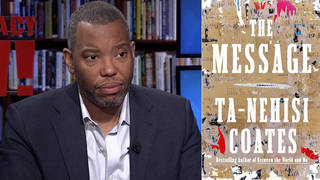
June 19 is Juneteenth, celebrating the day in 1865 when the last enslaved Black people in the United States learned they had been freed from bondage. As momentum grows to enshrine it as a national holiday, we speak with author and historian Gerald Horne, who says that while the story of Juneteenth is “much more complicated and much more complex than is traditionally presented,” increased recognition of the day “provides an opportunity to have a thorough remembrance of this horrific system that was slavery.”
Transcript
AMY GOODMAN: This is Democracy Now!, democracynow.org, The Quarantine Report. I’m Amy Goodman. President Trump was originally slated to speak in Tulsa today, June 19th, a holiday celebrated around the country as Juneteenth. It was June 19th, 1865, when enslaved people in Texas first learned they were free, two years after Abraham Lincoln signed the Emancipation Proclamation. Trump moved his rally [back] by one day after facing widespread criticism.
On Thursday, he told The Wall Street Journal, “I did something good: I made Juneteenth very famous. It’s actually an important event, an important time. But nobody had ever heard of it,” he said. In fact, 47 states and the District of Columbia already recognize Juneteenth as a state or ceremonial holiday. Senators Kamala Harris, Cory Booker and Republican Senator John Cornyn of Texas now say they want to make it a national holiday. It’s already an official paid holiday for state employees in four states, including Texas and New York.
It was on this day in 1865 when enslaved people in Galveston, Texas, first heard of their liberation. On that day, Union Army General Gordon Granger publicly read General Order No. 3, which stated, quote, “The people of Texas are informed that … all slaves are free,” unquote. Word spread, and spontaneous celebrations ensued. It had been more than two-and-a-half years since President Lincoln issued the Emancipation Proclamation.
In a 1941 audio interview recorded by the Library of Congress, Laura Smalley, born into slavery in Texas, recalled learning of her freedom as a child. The plantation owner who enslaved her, Mr. Bethany, had returned from war but didn’t tell those he enslaved that the Confederacy had lost and that they were free.
LAURA SMALLEY: Old master didn’t tell you no one was free.
INTERVIEWER: He didn’t tell you that?
LAURA SMALLEY: No, he didn’t tell. They worked there — I think now they say they worked them six months after that — six months — and turned them loose on the 19th of June. That’s why, you know, we celebrate that day, colored folks celebrates that day.
AMY GOODMAN: For more, we go to Houston, Texas, where celebrations marking Juneteenth will take place today, as they have since the 1890s. We’re joined by a professor of history and African American studies at the University of Houston, author of many books, including one just published this month, The Dawning of the Apocalypse: The Roots of Slavery, White Supremacy, Settler Colonialism, and Capitalism in the Long Sixteenth Century.
Gerald Horne, we welcome you back to Democracy Now! It’s great to have you with us. Can you talk about the history of Juneteenth?
GERALD HORNE: Well, thank you for inviting me. And first of all, let me say that I salute those who are now pushing for a federal holiday for Juneteenth. It’s long overdue.
Second of all, let me say that the traditional story of Juneteenth is somewhat flawed, insofar as the Emancipation Proclamation of January 1st, 1863, did not necessarily extend to Texas, where the United States did not exercise meaningful sovereignty.
Point number two is that Juneteenth also needs to be seen in the context of a larger scheme by slaveholders in Texas. You all know, I’m sure, that we celebrate Cinco de Mayo, May 5th, which marks a time when Mexicans rose up against the French puppet ruler, speaking of Maximilian. Recall, as well, that Texas had seceded from Mexico in 1836 and became an independent republic, not least because Mexico had moved towards abolition of slavery in the 1820s under a president of Indigenous and African descent, speaking of Vicente Guerrero. So the idea for the enslavers in 1865 was to try to return to Mexico under French rule and extend the lease on life of slavery.
This plot, this scheme, may have succeeded but for an uprising by the Mexican people that drove Maximilian out of office, leading to his execution, that was joined by Black soldiers, including an early Black historian, George Washington Williams. You may want to consult the biography of him by the late historian John Hope Franklin. And it presents a remarkable story of Black-Brown unity against white supremacy that I think we can learn from.
AMY GOODMAN: And so, take it forward from there and explain, first, what exactly Abraham Lincoln signed with the Emancipation Proclamation in 1863, why it took two years for enslaved people in Texas to learn of this, but even with this Emancipation Proclamation, it did not free enslaved people in places like Kentucky, in places like Delaware and Maryland.
GERALD HORNE: You have to see the Emancipation Proclamation as a war-fighting measure. Its remit did not necessarily extend to slaveholders who remained true to the Lincoln government. Its remit did extend to states like Texas, where the United States did not enjoy meaningful sovereignty.
Then, the larger point is, there’s evidence to suggest that even after June 19th, 1865, unpaid labor of Africans continued at least for months, perhaps longer — we still need research on that. And in any case, a kind of neoslavery erupted, speaking of the convict lease system, whereby Black men, in particular, were arrested on a flimsy pretext and then were leased out en masse to plantations where they formerly had been enslaved laborers.
So, this whole story of Juneteenth is much more complicated and much more complex than is traditionally presented. But having said that, once again, I salute those who are pushing for a federal holiday with regard to Juneteenth, because it provides an opportunity to have a thorough remembrance of this horrific system that was slavery. It allows an opportunity to connect the toxicity of the past to the carnage in the streets that you just saw three weeks ago in Minneapolis, Minnesota, and just recently in Atlanta, Georgia. It allows us to recognize that slavery created a system and a culture where Black life is cheap and worthless. It created a culture where Blackness itself is degraded.
And also, I should add that when slavery was abolished, the slave owners were not compensated. Of course, this discourse today is about reparations to the descendants of the enslaved, but unlike in the British Empire in the 1830s, where the slave owners were compensated, they were not compensated in Dixie. And what that means is that you had a lot of animosity and antipathy, to put it mildly, to the newly freed Africans, which then boiled over into the rise of the Ku Klux Klan and, arguably, created this culture which allows a kind of Klan mentality to continue to persist amongst police departments, such as in Minneapolis, and amongst vigilantes, which, of course, led to the death of Ahmaud Arbery in Brunswick, Georgia, months ago.
AMY GOODMAN: And can you talk about the naming of military bases after Confederate generals, not at the time of the Confederacy, but decades later, or even the erecting of these statues all over the South — I think Virginia has many other than any other state — erected well after the Civil War, and what their significance was in the 20th century?
GERALD HORNE: Well, it represents, clearly, lost cause mythology. As should be recognized, Dixie, the Confederacy, lost militarily but did not lose politically, as evidenced by the fact that you have these statues to heroes of enslavement, and fewer statues still to those who fought against slavery, and fewer statues still to the descendants and the enslaved themselves.
I’m happy that Speaker Pelosi decided to remove these portraits of Confederate leaders and speakers from the Capitol; however, she must be asked: Why did it take so long?
And with regard to these monuments, such as on Monument Avenue in Richmond, Virginia, the question is — they represent a version of history. That is to say, they represent a lost cause mythology. They represent a history that, in some ways, sanitizes and whitewashes a horrific system of enslavement. And in any case, I think it’s too much to ask Black citizens, in particular, not to mention all Democratic-leaning people, to subsidize the upkeep of these monuments through their tax dollars, which represent a violation of the basic precepts of democracy.
AMY GOODMAN: You’re a history professor, Professor Horne. You’re in Houston, Texas. Now there’s going to be a trail, an Emancipation Trail, that will run 51 miles from Galveston to Houston to trace the route along which families traveled to spread the word of the emancipation?
GERALD HORNE: That’s true. And Galveston should be singled out. Galveston was a major slave port, particularly during the era when Texas was an independent country, from 1836 to 1845. Indeed, as you may know, a significant number of Black people in Cuba were basically arriving from Africa and taken to Galveston and then transshipped to Cuba, just like you saw the ships, the vessels of the so-called Lone Star Republic of Texas, off the coast of Angola in the early 1840s and off the coast of Brazil in the 1840s, where they were bringing enslaved Africans.
Part of that core of enslaved Africans included Jack Johnson, the former heavyweight boxing champion, now deceased, who was a man who helped to give rise to the so-called Great White Hope, this spasm of hysteria about a Black man being the heavyweight boxing champion. There’s a statue to him in Galveston as we speak. And Galveston is also the birthplace of Little Esther Phillips, the singer, whose signature tune, “Home Is Where the Hatred Is,” should be considered, I’m afraid to say, at this dire moment, as a new national anthem for Black Americans, not to mention Barry White, the deep-voiced crooner, who died in Los Angeles approximately 17 years ago.
AMY GOODMAN: Gerald, the Pulitzer Prize-winning journalist Nikole Hannah-Jones just tweeted, “The Emancipation Proclamation came abt partially because enslaved people were self-liberating by the thousands. Don’t let them tell you we just waited to be free,” she said.
GERALD HORNE: She is absolutely correct. And let me salute that Pulitzer Prize winner, Nikole Hannah-Jones. She turned the tables on establishment historians by writing in that now-famous essay in August 2019 in The New York Times Magazine that a motive force for the revolt against British rule in 1776 was the desire to preserve forevermore the system of enslavement, which is why the Confederates in 1861 considered themselves to be walking in the footsteps of real estate speculator George Washington.
This also helps to explain why Black people today are treated so atrociously, because, unlike some, Black people then, and mostly now, did not engage in class collaboration. They did not side with their slave masters, their slaveholders, in a slaveholders’ revolt that led to the creation of a slaveholders’ republic. And when you fight a war and lose, as Black people did in 1776, you can expect to be pulverized and penalized forevermore until you can turn the tables, which we began to do with the Haitian revolution, 1791 to 1804.
AMY GOODMAN: Your response, Professor Horne, to President Trump saying that it’s he who’s made people aware in this country of Juneteenth? Apparently, he learned of it only hours before by — he asked all around — this was his proof no one knew it — and finally found a Black Secret Service agent in the White House who could explain it to him.
GERALD HORNE: Well, I mean, it’s laughable. It’s ludicrous. It’s like the rooster taking credit for the rising of the sun. But more seriously, I don’t think that we need to entertain for that long the maunderings and the mutterings of the oaf in the Oval Office. And indeed, we should not rest until Agent Orange himself winds up in an orange jumpsuit in the International Criminal Court in The Hague for his many crimes and transgressions.
AMY GOODMAN: Gerald Horne, your final comment on this day, Juneteenth, also on this day before President Trump gives his address in Tulsa, opens his campaign rally, where so many, especially Black and Brown people, will be working inside the convention center — the arena, where he will be speaking, their own lives threatened by the COVID-19 surge there, and it being the 99th anniversary of the Tulsa race massacre, and amidst this protest, this uprising across the country against racism and police brutality?
GERALD HORNE: Well, all of these events, it seems to me, illustrate central themes in U.S. history. First of all, there is the theme of class struggle, as evidenced by the Africans who were part of a relationship that was the most profound of class exploitation, speaking of enslavement. They did not collaborate with their slave masters, as evidenced by the Haitian revolution, already alluded to. And, of course, they fought by the tens of thousands against their slave masters, so-called, from 1861 to 1865. And then you saw that tradition continue with the San Francisco General Strike of 1934 by the West Coast longshoremen, who of course are continuing that tradition still by shutting down West Coast ports, from Seattle to San Diego, in solidarity with Black Lives Matter and Juneteenth.
Then there’s the tradition of settler colonialism and class collaboration, whereby poor Europeans oftentimes collaborated with their slave masters to claim the land and dispossess the Indigenous population, and then collaborate in terms of militias, and the precursors of police forces, in keeping those two subordinated groups in line. I think that there’s still a struggle between these two lines of class struggle, on the one hand, and class collaboration, on the other.
AMY GOODMAN: We want to thank you so much for being with us, Gerald Horne, professor of history and African American studies at the University of Houston, author of a number of books, one just published, The Dawning of the Apocalypse: The Roots of Slavery, White Supremacy, Settler Colonialism, and Capitalism in the Long Sixteenth Century.
Up next, we go to Tulsa, Oklahoma, look at the spike of COVID-19 cases and speak with the sister of a man killed by police several years ago. They are the great-grandchildren of a survivor of the 1921 race massacre in Tulsa. Stay with us.
[break]
AMY GOODMAN: “No More Auction Block,” also called “Many Thousands Gone,” performed by Martha Redbone. The spiritual is often sung at Juneteenth celebrations.













Media Options